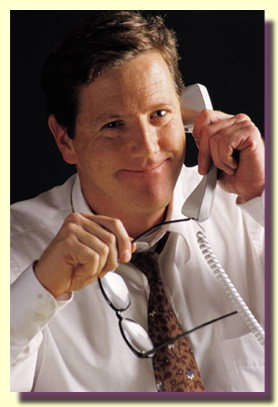
YoungEntrepreneur.com: It’s virtually impossible to own a business today and not have a website – but what makes a great website? For today’s Entrepreneur University we connected with Tim Knox. Tim is the founder and president of four successful technology companies and serves as an investor, mentor and advisor to many companies in his home town of Huntsville, Alabama. Here are Tim’s suggestions for how to build a great website:
Building an effective business website is a simple matter of definition.
Before the first graphic is drawn or the first line of code is written, you must define the website’s budget, purpose, target audience, design, navigation, and content. And when that’s all said and done you must define the marketing that will bring visitors to your site.
The 8 Things You Must Know To Build A Great Website [YoungEntrepreneur.com]
Category: How-To Guides
How To Attract Clients

Mind Petals: Here are a few simple ways to apply the Law of Attraction to get the right clients:
You might ‘call’ your clients in innovative ways. Instead of reaching out to your customers and clients in traditional forms—e-mail, voice messages, or even IM—think of ways you can make an appearance in their daily life instead. This is the basis of branding, but can be used in creative ways. Try a hand-delivered thank you note for a recent lunch, or a unique gift after a presentation that you both attended. Making sure the client has you on ‘top of mind’ can help generate further business with very little effort.
It’s also advantageous to be genuine with your marketing efforts. Much of marketing yourself may seem like ‘schmoozing,’ but being genuine in your relationships and partnerships will help things flow with ease. When you both have a goal or intention in mind, the process is much simpler and much more natural.
You can also try predicting the response you want. If you have a ‘gut feeling’ that your client, or prospective clients, may be interested in something you can provide, find a way to highlight the value for them and send it their way. Sometimes simply spelling out how something can help them is all it takes to capture their interest.
Finally, look for ways to move towards a richer relationship. Attracting clients doesn’t always lead to a direct sale—maybe you can reach out to them for referrals, building your portfolio of other work, or simply as a resource. Knowing how to nurture and maintain relationships involves a positive, growth-oriented mindset and your intention can help guide you towards long-term clients with much less resistance.
The Law of Attraction for Snagging New Clients [Mind Petals]
How To Create Your Own Radio Ad

Marketing Deviant: Making a radio advertisement is a good way to target consumers into buying your products or services. In this short article, I’ll show you how to make your very own radio advertisement for little to no cost. You can use a voice recorder to record your ad, but I advise using a computer or laptop with a microphone so you can record your ad and mix in music much easier and faster to create a radio ad.
To record from your computer, you can download some free voice recording programs from Download.com or use the “sound recorder” provided from your Operating System. It should be located inside the “accessories” folder in “program files” (Windows Vista). Most radio ads run for 15, 30 or 60 seconds. In your radio ad you could explain what products or services you offer with the name of your company, website, location, and phone number. If you are selling a very high advance product then you would need to explain the functions and the reason why it is beneficial to buy it from your ad.
Next you would need music to make your radio ad more appealing. There are free programs to combine your recording and music file together. Using download.com again, type in keyword “music mix” and use the “freeware filter box” and choose the programs you want to use (Window Vista users may have a hard time finding free music mix programs). The music you use for your ad cannot be “louder” than your message or your advertisement would be ineffective. If you use music for your ad, you must ask for permission from the music artist (expect to pay a royalty fee) who created it unless you created it! However, there’s a site that gives insight on public domain music which can be used without paying royalties.
Once you are done with your ad, you just saved from a few hundred to a thousand dollars just by creating the ad yourself.
How to Create a Radio Ad [Marketing Deviant]

This is an article submitted by Eric Feng. Submit your article! Find out more.
Blooper #1: Not telling us why we should listen to you
Never assume that just because you have an audience, we are obliged to listen to you. We may love you (that’s why we came in the first place) but never take advantage of the trust we have for you. It is an extreme turn-off when the audience has to do the work i.e. figure out how your presentation is relevant to us. We are a bunch of selfish egomaniacs. We love ourselves so much! And we don’t care about your experiences unless it teaches us something that we can use for ourselves. So here’s a word of advice: If you want to share your experiences, please do. But always include a message, something that will benefit us, your beloved audience!
Blooper #2: Ignoring us throughout your speech
We get bored easily. Period. If you keep talking about you, you, you, you, you… we will switch off. We want to be part of your speech. We really do. Get us involved. It could be as simple as asking us a question. It gives us a chance to hear ourselves talk. It could be as simple as playing a mini game with us. It gets us up on our seat. Please entertain us! Make us love you. We really want to because if you keep ignoring our needs, we will do the same. Lucky for the speaker, he allowed us to ask questions at any point in his presentation and guess what, we did! In my opinion, that was his saving grace!
Blooper #3: Going overtime
No matter how good you are, never ever go over time!!! Unless we paid you thousands of dollars to teach us something and you are about to share with us the ultimate secret to earning another ten million. If you want your audience to love you, end earlier than expected! It tells us that you respect our time. It makes you special because most speakers don’t observe that. And guess what, the next time you give your presentation; we will be there to support you!
Blooper #4: Spelling errors on your slides
If you have glaring spelling mistakes in your slides, here’s the image you are portraying to your audience: sloppy and cannot be bothered. Unless that’s what you want the audience to think of you, I suggest you get someone to do a spell check.
Blooper #5: Bad pronunciation of words
It cracks me up when some presenters stumble upon the same word every single time, without any sign of remorse. There was one time I sat through a presentation where the team had to review a company’s product named Morange. And throughout the ten minutes presentation, they came up with oh so many ways to pronounce this word.
And I swear one time I heard Moron. They might as well labelled the product Moronic Morange. That would be… memorable. Some “credit” has to be given to the company who named their product mo-range.
Blooper #6: Reading off the script
Although my preference is to go without a script, sometimes there is a need for it. However more often than not, speakers are too reliant on their script. You see them referring to their script even if it is just reading their name and designation??!! Yes, this is very puzzling. I once came across a book that taught me how to read from a script. Here’s the golden rule. Never ever speak when your eyes are on your script. Instead, you should follow this three-step process: see, stop, say.
First, look down and take a snapshot of your script. Memorize a chunk of words. Bring your head up and then pause for a second. When you are ready, say what you have memorized in your own words. It’s a three-step process: see, stop and say. It is very important that you pause. Yes, it may be weird for you but in reality, the pause helps make your speech conversational. It also creates anticipation, which further deepen the impact.
Blooper #7: Starting your presentation weak
Maybe it is just me but I get really pissed off when a speaker starts off his presentation with “Urm.. I guess I should probably start… ah ok, here goes…”. Or even worse “I am not really prepared for this presentation because (give some lame excuse). But anyway, I will start…” Trust me, giving excuses of why you may not do a good job will hardly win the sympathy of your audience. Instead, you will make us feel that we are unworthy of your time. You will be better off not giving the presentation since no one will be listening anyway.
As the saying goes, you will not get a second chance to make a good first impression. So make full use of your first 30 seconds to impress your audience. Here are a couple of ways you can start a presentation powerfully. You can tell a personal story and relate it back to the message of your presentation. Starting your presentation with a visual stimulating or humorous video clip will also create impact. Or begin with a thought provoking quote or a shocking statistic, which will create the listening for your presentation. All these are far more superior to your usual good morning/afternoon/evening niceties or worse, apologies.
Eric Feng is an acclaimed public speaking coach and he blogs at http://blog.ericfeng.com. Get a free chapter of his soon-to-be published book at http://www.thefaqbook.com before it’s taken down.
How To Raise Money For An Invention
 Inventor Resource: The initial funding for independent inventions normally comes from ‘friends family and fools’, but once this is exhausted, and you need to progress to the next stage of development, you will need to find other funding.
Inventor Resource: The initial funding for independent inventions normally comes from ‘friends family and fools’, but once this is exhausted, and you need to progress to the next stage of development, you will need to find other funding.
Grants
There are a number of publicly funded grants available for innovative businesses, some of which can be applicable to inventors. There are two levels of grant suited to independent inventors, and each will require some funding commitment from the applicant, aside from the grant. ‘Micro projects’ are described as ‘simple low-cost development projects lasting no longer than 12 months’. With a maximum grant of £20,000, this is probably the most appropriate for inventors starting out with the development of a new product. ‘Research projects’, lasting 6-18 months, can receive a maximum grant of £75,000, with the aim being ‘to investigate the technical and commercial feasibility of innovative technology’. For more radical inventions, perhaps using new materials or advanced technology, or involving external partners, these are appropriate.
Loans
Do not re-mortgage your house in order to pay for your invention, no matter how brilliant it may seem. If one piece of advice comes through clearly time and time again from inventors who’ve ‘been there’, it’s this.
Small business loans are suitable, however. By presenting yourself as an entrepreneur — a businessperson looking to involve the bank in a mutually profitable relationship (even if you think of yourself as a ‘garden-shed-in-your-spare-time’ inventor) — you stand a good chance of receiving a favourable loan. If your business takes off, quite apart from the interest on the loan, the bank will want to have you as a customer, since business banking charges are a significant proportion of banks’ income.
Venture Capital
Venture capital is most often appropriate for inventors who have made significant progress with their invention and are well on the way to turning it into a successful business. In this sense it should not be seen as a first option for funding your invention. Venture capitalists, or private equity financiers, are looking to make significant returns on the money they invest — which typically belongs to others, as part of a fund — and clearly want to maximise the upside of the risk while minimising the downside.
How Do I Raise Money for an Invention? [Inventor Resource]